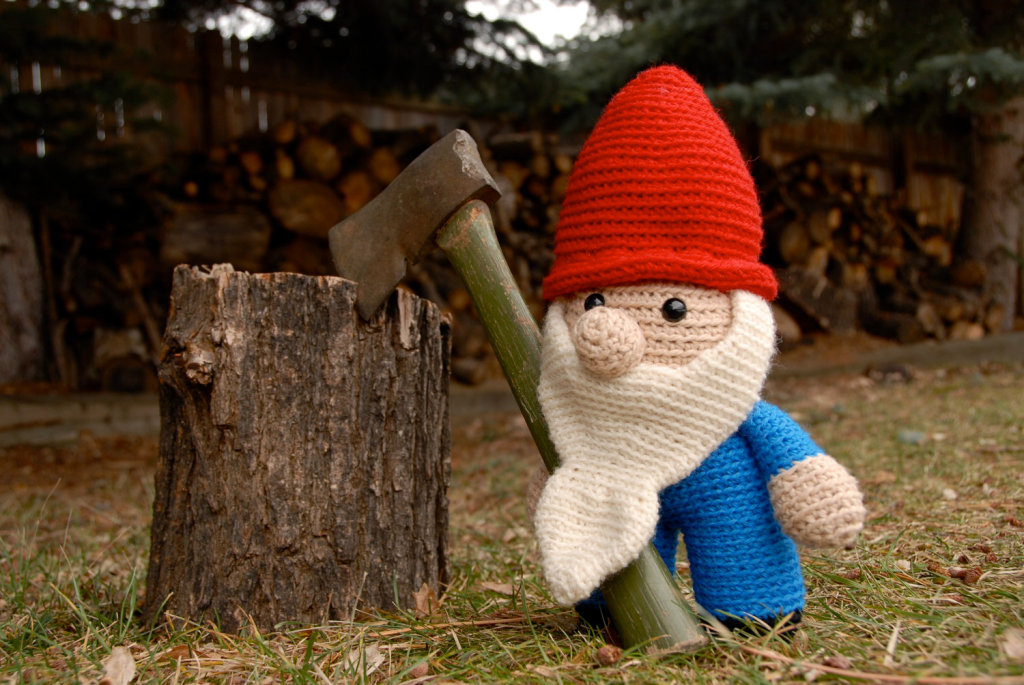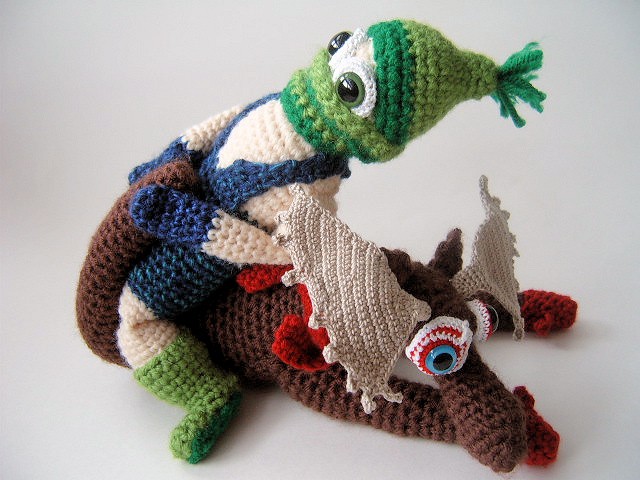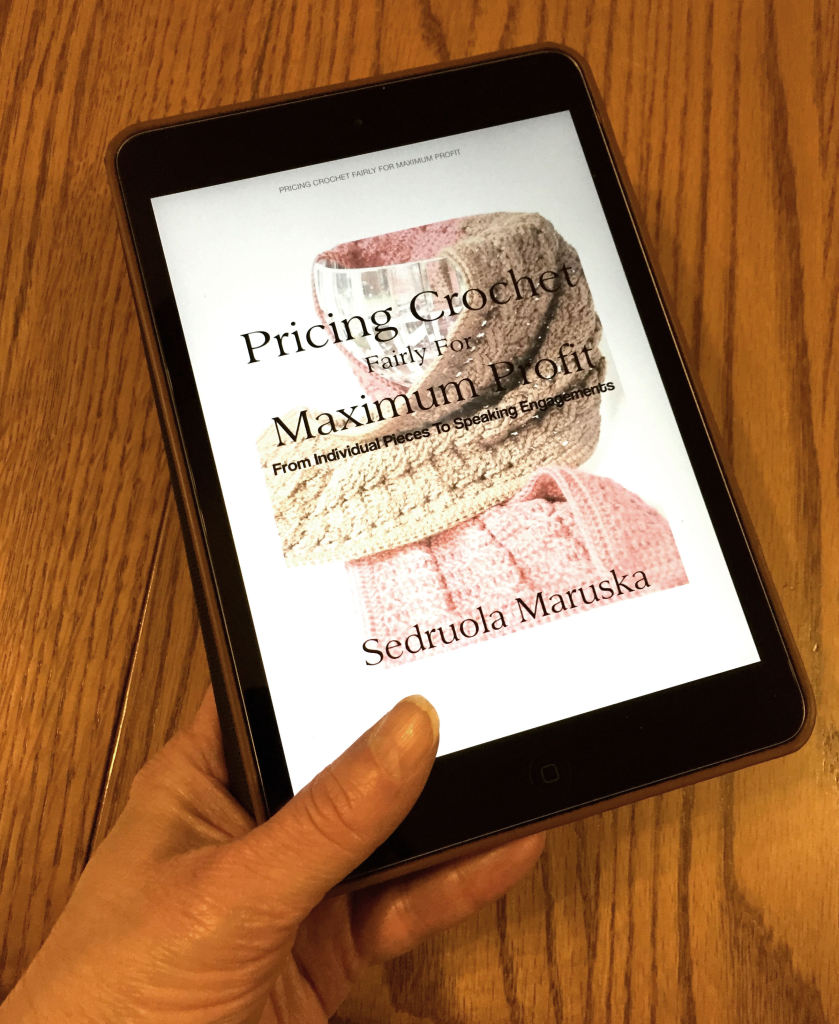If you sell your crocheted items online or locally, you’ve probably struggled with how to price your goods appropriately. After almost seven years of selling my crocheted and felted items on Etsy, I still find setting a price to be a difficult task. The challenge is to arrive at a price that is fair for the consumer, but still provides a profit for you. Additionally, crocheted (or knitted) items take longer to finish than many other handmade items, so it’s hard to figure out how to factor in an hourly rate. Complicating the pricing issue is the fact that everyone has a different idea about what feels profitable; there really isn’t a one-size-fits-all pricing formula. Some people are hobbyists and are content when their material costs are covered, or if they make slightly more than what their yarn and embellishments cost. Others may feel they are experts in their field and that their time—in addition to their material costs—needs to be taken into account when pricing items. There is likely a range of attitudes between these two extremes—and none of them are incorrect when you view them in relationship to the crocheter’s selling goals.
To shed some light on how to price your crocheted items, I decided to research the opinions of other blogger/crocheters. Some of their opinions will mesh well with yours, and others may grate against you, but in any event I hope you find these opinions helpful in clarifying your own thinking about pricing your crocheted work.
I began my research with a podcast, Pricing and Selling your Crocheted Items, recorded by Stacie Trock Hunter of Fresh Stitches. Tracie designs amigurumi, patterns, and plushies, and is a Craftsy crochet instructor. She also sells her amigurumi creatures and patterns on Etsy in her Fresh Stitches shop. In addition, she is the author of Modern Baby Crochet, Crocheted Softies, and Cuddly Crochet.

Stacie believes there has to be a middle ground between being a hobbyist who charges just enough to cover the cost of materials, and the idea that a skilled craftsperson—someone who has an art or technical skill that others don’t—should be paid for every hour worked.
There’s only so much that people out there are going to pay. Unless you’re selling to Oprah, there’s a limit on what the average American is going to shell out for a stuffed animal or handmade item.
She suggests that instead of tracking every hour worked and then charging for that time, most crocheters can earn a living wage by incorporating a few business strategies:
- Limit the number of custom items you offer. They take extra time that you often do not recoup.
- Limit the range of items you produce so that you can become more efficient at producing them quickly. In other words, familiarity breeds efficiency, and as you become more efficient with your process, keep in mind that you’re still charging the same price for what you used to finish more slowly.
- Look for ways to cut material costs, such as buying yarn in bulk, or limiting your color selection to, for example, three neutral colors and three popular colors.
- Look for ways to add value to a sale that a customer might be willing to pay for, but don’t really cost you that much extra. For example, offer customization of an item, but in limited ways you can control. Stacie has an owl pattern she uses frequently, but allows customers to choose the color for the owl’s body, eyes and feet. Consider offering package wrapping services, too, especially during the holidays.
- Keep a photo portfolio that you can share with potential customers.
- Consider using better quality materials, with the assumption that customers will pay a little more for that quality (wool vs. acrylic, for example).
- Have an honest conversation with yourself about much you need to earn per hour that would make you happy, and factor that into your price.
- Look at the market to see what others charge.
Stacie refers to another experienced crocheter, Jess Schleicher, in her podcast. Jess blogs at Knot by Gran’Ma, and also sells fanciful crocheted monsters and patterns in her Etsy shop by the same name. Like Stacie, she sells patterns on Craftsy, as well as on Ravelry.

In her blog post, Let’s Talk About Pricing, Baby. A Rant., Jess stresses that if you are a skilled craftsperson, you need to be paid for your time.
You cannot make a hat in an hour, charge $15, and say that you paid yourself for your time and supplies. I’m sorry. It is an impossibility.
Instead, Jess suggests the following pricing strategy:
- Figure out a minimum wage for yourself, but keep in mind that you are a skilled craftsperson.
- Determine how many hours it takes you to produce an item, and apply your rate.
- Track your supply costs.
- Add the above numbers together to determine your wholesale price.
- Double the wholesale price to decide your retail price.
Michael “Mikey†Sellick, the face behind The Crochet Crowd blog, Facebook page, and YouTube instructional videos, appears to disagree with Jess about crocheters being able to charge for their time. In his post, Prices for Crochet Afghans: Reality Check, he writes, “The price of finished crochet items isn’t as glamorous as we would hope to imagine.†He points out that though it isn’t fair, the average price for afghans is about twice the cost of materials. Yarn choices are everything, he claims, and value is in the eye of the buyer.
It depends how you market yourself, where you market yourself and your overall presentation.
Lorene Eppolite is another blogger/crochet designer who chimes in on the crochet pricing discussion. Lorene’s Web site, Cre8tion Crochet, aims to “help fellow artists and crafters to have successful businesses of their own.” Lorene offers free patterns and video tutorials, business articles about selling your crochet, and much more. She also designs for Darn Good Yarn, and you can find her patterns HERE. In her post, Pricing Crochet Items for Sale, Lorene says she used to take the material costs of a crocheted item and multiply that by 3 or 4, and then add a few dollars for embellishments. She points out, however, that this method did not cover all of her costs.
Doing it this way did not take into account my operating costs above and beyond yarn and time. What about my electric costs, internet usage, etc., that went along with it? Shouldn’t I be compensated for that as well? That formula also didn’t take into thought my audience, who I will be selling to, or where I will be selling. What about my patterns, or my time if I want to teach a class?
Instead, Lorene recommends you follow the advice of Sedruola Maruska in her book, Pricing Crochet Fairly for Maximum Profit, available on Amazon or on Maruska’s own Web site.
Sedruola “Sedie” Maruska is a self-taught crocheter and author. Her Web site, Yarn Obsession, offers crochet business advice, pattern links and crochet tips. In her post, Pricing Crochet Pieces for Sale online and beyond, Sedie says that what you actually crochet has an impact on the price you can charge, and so does the place where you plan to sell. Are you selling in a flea market, or in a gift shop? These places cater to different markets. Think about who you want to attract to your product. In addition, consider the cost of materials, your time, the fees you are paying, and how much profit you want to make.
At the end of the day, it is a business, and you are trying to make money.
Sedie claims that one of the things she has noticed is that crocheters routinely undervalue the time they invest in their business. “Your time is not only the time you spend making your items,” she says, “but your time is the time you spend taking pictures of your items and posting your items online for sale, or creating your flyers, or creating your ads to be posted online or in a magazine, or wherever it is that you are doing your advertising for your business.”
One formula that works for Sedie is take the cost of materials, add the fees, and triple that amount. She feels this results in reasonable pricing that still brings a profit. She suggests that you should not compare your prices to someone else’s because that person may not have the same business vision that you have. In her book, Pricing Crochet Fairly for Maximum Profit, she is quick to point out that the formulas she includes are guidelines only, and that guidelines are not rules but instead starting points:
Remember, you are the only one who can determine if a pricing strategy is going to work for you and your target. Therefore, if a formula isn’t quite right, adjust it to your needs.
Because so many crocheters sell on Etsy, her Web site provides the following calculation tools:
Of all the opinions voiced by crocheters in this post, I think that Sedie Maruska’s approach may be the most balanced. I did download her book and discovered it to be filled with practical formulas you can apply to all kinds of selling venues: online, craft boutiques, craft shows, flea markets, or consignment shops. She also offers advice for special situations, such as commissioned pieces, selling to friends and family, or selling to non-profits. Her book covers marketing basics, selling patterns and testing them, teaching crochet, and public speaking. If you skim through the table of contents in her book, you quickly realize that there are many more possibilities for selling your crocheted work than you might have imagined.
Do you have a crochet (or knitting) pricing strategy you’re willing to share?
© 2014 Judy Nolan. All rights reserved.


Excellent information! I hate to see someone listing, say, a baby afghan, and charging such a small amount that you know the yarn isn’t even covered. It’s hard to figure though, and you’ve provided some great links with helpful advice. The fee calculators will come in handy too!
I don’t sell fiber arts, but these are great tips. I agree with Sarah that I feel vicariously frustrated when I see a listing that I believe doesn’t even cover the materials costs. Pricing handmade is so very difficult.
I have such a hard time pricing my Name Albums! They are so time consuming! But I know if I charged by the hour + supplies, they would never sell. I had to find a middle ground. And they are an item I would never consider selling wholesale, so I don’t worry about doubling my initial price for retail vs. wholesale. I try to decide what I think buyers would be willing to spend and what I’m willing to sell for and price somewhere in the middle. So hard sometimes!
Thanks for such an informative article – much needed near the Holidays when Sales increase. It is quite difficult to price items according. I base it on the type of Yarn I have used (some ArtYarns are over $50/skein) then the time. I truly think I lose out on that aspect as some of my Sweaters take at about 5 days working 24/7 to make – everyone has a deadline – like I need it in a week! Definitely doing to check out Sedie Maruska’s book. Thanks!
One thing I try to keep in mind, whether I sell an item or not, is that I would likely be spending my evenings working on some sort of knit or crochet project anyway. It makes it a little easier to rationalize that my “hourly wage” for a project (that I could easily work on for 20-100 hours or more) is significantly less than the federal minimum wage. Being able to make a profit doing what I love is priceless 🙂
Thank you for this post. I have been selling since June of 2014. I have sold a couple of my baby items. I have been told by many other crocheters and friends that I am under cutting myself. I found a spreadsheet that does the calculations for me but it is really hard to wrap my head around charging $57.20 for my Ugg inspired crocheted baby boots with fur or a baby girl dress that took me forever to make for $501.60 because that is the retail price. I am so utterly frustrated because I have not been able to find the sweet spot. I want to make this a viable business but I don’t want to charge so much that no one will buy and I don’t want to undercut myself any longer because I create a fabulous product. I’m 43 and have been crocheting since I was 7. I have years of experience and deserve to charge a fair price. Sedie’s, whom I recently discovered about a month ago, approach sounds more reasonable to me.